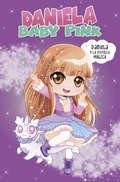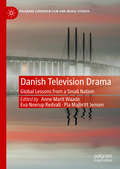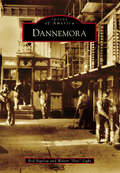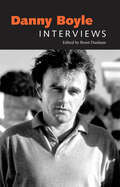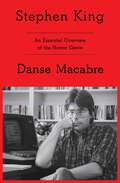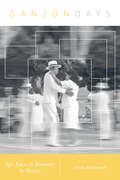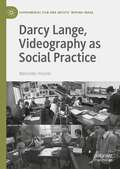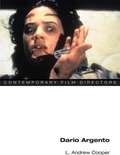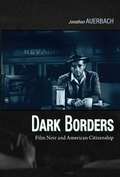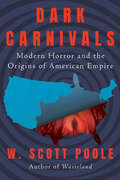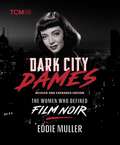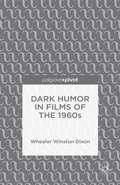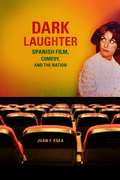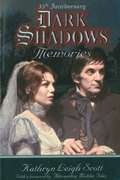- Table View
- List View
Daniela y la estrella mágica
by Daniela Baby Pink Henar TorinosPresentando la primera historia protagonizada por la espectacular Daniela Baby Pink. ¡Es el cumpleaños de Daniela Baby Pink! ¿Qué regalo fantástico habrá preparado Bea, su mamá? ¡Es una estrella con la que iluminar su habitación por las noches! Pero aquella noche, cuando Daniela se despierta y toca la estrella, es transporada a Siltora, un reino mágico poblado por seres fantásticos que sufre la amenanza de los malvados kabog, unos monstruos que quieren acabar con la luz del universo... ¿Será Daniela la elegida para acabar con esta amenaza, como todos dicen?¿Será de verdad una princesa?
Danish Mothers On-Screen (Palgrave Studies in (Re)Presenting Gender)
by Djuna HallsworthThis book combines content analysis of film and television cases, the examination of policy documents, and first-hand interview material with Danish industry professionals, tracing the pivotal moments in media and welfare state history to unite these two overlapping spheres: welfare state social policy and media imagery. In doing so, it addresses a gap in existing academic and policy documents to demonstrate how motherhood and femininity are presented in contemporary state-supported Danish screen fiction. As an industry premised on state funding and public service values, Danish screen fiction plays a cogent role in shaping and communicating cultural norms and provides a space for the cultivation of belonging and a sense of a shared identity. For this reason, it is vital to identify and examine representational trends and patterns in popular media formats. This book argues that the political narrative of gender equality, democracy and universal social support that permeates Danish state policy is undermined in screen fiction, wherein working mother characters are problematised and the welfare system’s integrity is challenged. This book asserts that the framing of femininity, motherhood and citizenship in many contemporary Danish films and television dramas indicates a cultural concern about the welfare state’s institutionalisation of caregiving and presents absent mothers as an indirect cause of crime, trauma or social unrest.
Danish Television Drama: Global Lessons from a Small Nation (Palgrave European Film and Media Studies)
by Anne Marit Waade Eva Novrup Redvall Pia Majbritt JensenThis book explores how to understand the international appeal of Danish television drama and Nordic Noir in the 2010s. Focusing on production and distribution as well as the series and their reception, the chapters analyse how this small nation production culture was suddenly regarded as an example of best practice in the international television industries, and how the distribution and branding of particular series – such as Forbrydelsen/The Killing, Borgen and Bron/The Bridge – led to dedicated audiences around the world. Discussing issues such as cultural proximity, transnationalism and glocalisation, the chapters investigate the complex interplays between the national and international in the television industries and the global lessons learned from the way in which screen ideas, production frameworks and public service content from Denmark suddenly managed to travel widely. The book builds on extensive empirical material and case studies conducted as part of the transnational research project ‘What Makes Danish Television Drama Travel?’
Danièle Huillet, Jean-Marie Straub: Objectivists in Cinema (Film Culture in Transition)
by Benoît TurquetyDanièle Huillet and Jean-Marie Straub collaborated on films together from the mid-1960s through the mid-2000s, making formally radical adaptations in several languages of major works of European literature by authors including Franz Kafka, Bertolt Brecht, Friedrich Hölderlin, Pierre Corneille, Arnold Schoenberg, Cesare Pavese, and Elio Vittorini. The impact of their work comes in part from a search for radical objectivity, a theme present in certain underground currents of modernist art and theory in the writings of Benjamin and Adorno as well as in the Objectivist movement, a crucial group within American modernist poetry whose members included Louis Zukofsky, George Oppen, and Charles Reznikoff, with connections to William Carlos Williams and Ezra Pound. Through a detailed analysis of the films of Straub and Huillet, the works they adapted, and Objectivist poems and essays, Benoît Turquety locates common practices and explores a singular aesthetic approach where a work of art is conceived as an object, the artist an anonymous artisan, and where the force of politics and formal research attempt to reconcile with one another.
Dannemora
by Walter Pete" Light Rod BigelowThe discovery of iron ore near Chateaugay Lake in 1831 started the settlement later known as the town of Dannemora. In 1832, several local businessmen entered into partnership to mine the ore. St. John B.L. Skinner, a lawyer in Plattsburgh, owned most of the land and named it Dannemora. Dannemora's history is intertwined with iron ore and the development of the prison. The town is located in Clinton County in the foothills of Dannemora Mountain and is within the Blue Line, which marks the border of Adirondack Park. The prison is built on the side of the mountain, and a building to its right, which was the State Hospital for Insane Convicts, is now called the Annex. Surrounding Dannemora are Lyon Mountain, Chazy Lake, and Upper Chateaugay Lake.
Danny Boyle: Interviews (Conversations with Filmmakers Series)
by Brent DunhamA humble man from humble beginnings, Danny Boyle (b. 1956) became a popular cinema darling when Slumdog Millionaire won big at the 2009 Academy Awards. Prior to this achievement, this former theater and television director helped the British film industry pull itself out of a decades-long slump. With Trainspotting, he proved British films could be more than stuffy, period dramas; they could be vivacious and thrilling with dynamic characters and an infectious soundtrack. This collection of interviews traces Boyle's relatively short fifteen-year film career, from his outstanding low-budget debut Shallow Grave, to his Hollywood studio films, his brief return to television, and his decade-in-the-making renaissance. Taken from a variety of sources including academic journals, mainstream newspapers, and independent bloggers, Danny Boyle: Interviews is one of the first books available on this emerging director. As an interviewee, Boyle displays an engaging honesty and openness. He talks about his films 28 Days Later, Millions, and others. His success proves that classical storytelling artists still resonate with audiences.
Danny, King of the Basement: Revised Second Edition
by David S. CraigIn two years, Danny and his mom have moved more often than most kids lose teeth... When Danny moves into a new basement apartment, the kids he meets seem to have way more problems than just being hungry. But Danny’s imagination creates a community that allows his friends to cope with their problems and ultimately to help Danny—because his crisis isn’t losing a home. It’s gaining one…
Danse Macabre
by Stephen KingBefore he gave us the &“one of a kind classic&” (The Wall Street Journal) memoir On Writing, Stephen King wrote a nonfiction masterpiece in Danse Macabre, &“one of the best books on American popular culture&” (Philadelphia Inquirer).From the author of dozens of #1 New York Times bestsellers and the creator of many unforgettable movies comes a vivid, intelligent, and nostalgic journey through three decades of horror as experienced through the eyes of the most popular writer in the genre. In 1981, years before he sat down to tackle On Writing, Stephen King decided to address the topic of what makes horror horrifying and what makes terror terrifying. Here, in ten brilliantly written chapters, King delivers one colorful observation after another about the great stories, books, and films that comprise the horror genre—from Frankenstein and Dracula to The Exorcist, The Twilight Zone, and Earth vs. The Flying Saucers. With the insight and good humor his fans appreciated in On Writing, Danse Macabre is an enjoyably entertaining tour through Stephen King&’s beloved world of horror.
Danzón Days: Age, Race, and Romance in Mexico (Music in American Life)
by Hettie MalcomsonOlder people negotiating dance routines, intimacy, and racialized differences provide a focal point for an ethnography of danzón in Veracruz, the Mexican city closely associated with the music-dance genre. Hettie Malcomson draws upon on-site research with semi-professional musicians and amateur dancers to reveal how danzón connects, and does not connect, to blackness, joyousness, nostalgia, ageing, and romance. Challenging pervasive utopian views of danzón, Malcomson uses the idea of ambivalence to explore the frictions and opportunities created by seemingly contrary sentiments, ideas, sensations, and impulses. Interspersed with experimental ethnographic vignettes, her account takes readers into black and mestizo elements of local identity in Veracruz, nostalgic and newer styles of music and dance, and the friendships, romances, and rivalries at the heart of regular danzón performance and its complex social world. Fine-grained and evocative, Danzón Days journeys to one of the genre’s essential cities to provide new perspectives on aging and romance and new explorations of nostalgia and ambivalence.
Darcy Lange, Videography as Social Practice (Experimental Film and Artists’ Moving Image)
by Mercedes VicenteThe Videography of Darcy Lange is a critical monograph of a pivotal figure in early analogue video. Trained as a sculptor at the Royal College of Art, Lange developed a socially engaged video practice with remarkable studies of people at work in industrial, farming, and teaching contexts that drew from conceptual art, social documentary and structuralist filmmaking. Lange saw in portable video a democratic tool for communication and social transformation, continuing the legacy of the revolutionary avant-garde projects that merged art with social life and turned audiences into producers. This book follows Lange's trajectory from his early observational studies to the crisis of representation and socially engaged video and activism, as it is shaped by, and resists, the artistic, cultural and political preoccupations of the 1970s and 1980s. It strikes a balance between being a monographic account providing a close analysis of Lange's oeuvre and drawing from unpublished archival materials—a sort of catalogue raisonné—whilst maintaining a breadth with theoretical discourses around the themes of labour and class, education, and indigenous struggles central to his work. The book's frameworks of Conceptual Art, structuralist and ethnographic film theory, social documentary and the critique of representation, video as social practice and the notion of 'feedback', participatory socially engaged art and postcolonial and indigenous theory,—expand our understanding of video outside the predominant structuralist tendencies. Lange's transnational and nomadic career introduces notions of alterity and challenges nationalistic accounts that excluded him in the past.
Dare to Be Kind: How Extraordinary Compassion Can Transform Our World
by Catherine Avril Morris Lizzie VelasquezYouTube personality and celebrated motivational speaker Lizzie Velasquez shows us how we can learn to accept all parts of ourselves and others, and in doing so create a more compassionate world. Born with a rare genetic condition, Lizzie Velasquez always knew she was different, but not until she was older did she understand what that meant to others. At 17 years old, when she came across a viral video entitled "World's Ugliest Woman," only to discover that it featured her, she could no longer ignore what set her apart. She devoted herself to investigating the underlying sources of bullying and standing up on behalf of victims everywhere, creating one of the web's most popular YouTube channels and a TED talk that has drawn tens of millions of viewers. In this daring, inspirational book, Lizzie reveals the hidden forces that give rise to self-doubt, shame, and cruelty, and empowers us to redirect them to unlock empathy and kindness for ourselves and others. Through her own battles with anxiety and coping with disappointment, she demonstrates how we can overcome obstacles in our path and move forward with greater positivity and the right mental attitude. Brilliantly drawing on Lizzie's wisdom and sentiment, Dare to Be Kind presents the path to acceptance, love, and tolerance, and provides a framework to help us lead confident, resilient lives and, ultimately, forge a radically kind world.
Daredevil Circus Families / Daredevil Women (Fountas & Pinnell Classroom, Guided Reading)
by Pamela DellNIMAC-sourced textbook
Dario Argento (Contemporary Film Directors)
by L. Andrew CooperCommanding a cult following among horror fans, Italian film director Dario Argento is best known for his work in two closely related genres, the crime thriller and supernatural horror, as well as his influence on modern horror and slasher movies. In his four decades of filmmaking, Argento has displayed a commitment to innovation, from his directorial debut with 1970's suspense thriller The Bird with the Crystal Plumage to 2009's Giallo. His films, like the lurid yellow-covered murder-mystery novels they are inspired by, follow the suspense tradition of hard-boiled American detective fiction while incorporating baroque scenes of violence and excess. While considerations of Argento's films often describe them as irrational nightmares, L. Andrew Cooper uses controversies and theories about the films' reflections on sadism, gender, sexuality, psychoanalysis, aestheticism, and genre to declare the anti-rational logic of Argento's oeuvre. Approaching the films as rhetorical statements made through extremes of sound and vision, Cooper places Argento in a tradition of aestheticized horror that includes De Sade, De Quincey, Poe, and Hitchcock. Analyzing individual images and sequences as well as larger narrative structures, he reveals how the director's stylistic excesses, often condemned for glorifying misogyny and other forms of violence, offer productive resistance to the cinema's visual, narrative, and political norms.
Dark Allies (Star Trek #8)
by Peter DavidMany years ago, a bizarre alien lifeform known as the Black Mass consumed and destroyed an entire solar system in what was then the Thallonian Empire. Now the Black Mass has returned and its target is Tulan IV, homeworld of the fearsome Redeemers. Faced with near-certain destruction, the Overlord of the Redeemers is forced to turn to an unlikely ally: Captain Mackenzie Calhoun and the Starship Excalibur. Busy coping with the return of his rebellious son, Calhoun is none too eager to come to the aid of his despotic enemy; but when innocent lives are at stake he has no choice but to confront the implacable Black Mass. But how can one solitary Starship hope to turn back a force capable of consuming entire suns?
Dark Borders: Film Noir and American Citizenship
by Jonathan AuerbachDark Borders connects anxieties about citizenship and national belonging in midcentury America to the sense of alienation conveyed by American film noir. Jonathan Auerbach provides in-depth interpretations of more than a dozen of these dark crime thrillers, considering them in relation to U. S. national security measures enacted from the mid-1930s to the mid-1950s. The growth of a domestic intelligence-gathering apparatus before, during, and after the Second World War raised unsettling questions about who was American and who was not, and how to tell the difference. Auerbach shows how politics and aesthetics merge in these noirs, whose oft-noted uncanniness betrays the fear that "un-American" foes lurk within the homeland. This tone of dispossession was reflected in well-known films, including Double Indemnity, Out of the Past, and Pickup on South Street, and less familiar noirs such as Stranger on the Third Floor, The Chase, and Ride the Pink Horse. Whether tracing the consequences of the Gestapo in America, or the uncertain borderlines that separate the United States from Cuba and Mexico, these movies blur boundaries; inside and outside become confused as (presumed) foreigners take over domestic space. To feel like a stranger in your own home: this is the peculiar affective condition of citizenship intensified by wartime and Cold War security measures, as well as a primary mood driving many midcentury noir films.
Dark Carnival: The Secret World of Tod Browning, Hollywood’s Master of the Macabre
by David J. Skal Elias SavadaThe definitive biography of Hollywood horror legend Tod Browning—now revised and expanded with new material One of the most original and unsettling filmmakers of all time, Tod Browning (1880–1962) began his career buried alive in a carnival sideshow and saw his Hollywood reputation crash with the box office disaster–turned–cult classic Freaks. Penetrating the secret world of &“the Edgar Allan Poe of the cinema,&” Dark Carnival excavates the story of this complicated, fiercely private man. In this newly revised and expanded edition of their biography first published in 1995, David J. Skal and Elias Savada researched Browning&’s recently unearthed scrapbooks and photography archives to add further nuance and depth to their previous portrait of this enigmatic artist. Skal and Savada chronicle Browning&’s turn-of-the-century flight from an eccentric Louisville family into the realm of carnivals and vaudeville, his disastrous first marriage, his rapid climb to riches in the burgeoning silent film industry, and the alcoholism that would plague him throughout his life. They offer a close look at Browning&’s legendary collaborations with Lon Chaney and Bela Lugosi as well as the studio politics that brought his remarkable run to an inglorious conclusion. With a revised prologue, epilogue, filmography, and new text and illustrations throughout, Dark Carnival is an unparalleled account of a singular filmmaker and an illuminating depiction of the evolution of horror and the early film industry.
Dark Carnivals: Modern Horror and the Origins of American Empire
by W. Scott PooleThe panoramic story of how the horror genre transformed into one of the most incisive critiques of unchecked American imperial power The American empire emerged from the shadows of World War II. As the nation&’s influence swept the globe with near impunity, a host of evil forces followed—from racism, exploitation, and military invasion to killer clowns, flying saucers, and monsters borne of a fear of the other. By viewing American imperial history through the prism of the horror genre, Dark Carnivals lays bare how the genre shaped us, distracted us, and gave form to a violence as American as apple pie. A carnival ride that connects the mushroom clouds of 1945 to the beaches of Amity Island, Charles Manson to the massacre at My Lai, and John Wayne to John Wayne Gacy, the new book by acclaimed historian W. Scott Poole reveals how horror films and fictions have followed the course of America&’s military and cultural empire and explores how the shadow of our national sins can take on the form of mass entertainment.
Dark City Dames: The Women Who Defined Film Noir (Revised and Expanded Edition)
by Eddie MullerIn this revised and expanded edition of his essential volume Dark City Dames, Eddie Muller—Turner Classic Movies host and author of Dark Cityand Noir Bar—offers a uniquely intimate look at the women who defined film noir, now featuring updated text, photos, and 10 new star profiles. Film noir was the dark side of the movies&’ happily-ever-after mythology. Sinister and sexy, it forged a new icon: the tough, independent dame. Determined, desirable, dangerous when cornered, she could handle trouble—or deal out some of her own. If you thought these women were something special onscreen, wait until you meet the genuine articles. In Dark City Dames, acclaimed film historian Eddie Muller takes readers into the world of six women who made a lasting impression in this cinematic terrain—from veteran &“bad girls&” Audrey Totter, Marie Windsor, and Jane Greer to unexpected genre fixtures Evelyn Keyes, Coleen Gray, and Ann Savage. The book provides in-depth profiles of these formidable women during the height of their careers, circa 1950, as they balanced love and career, struggled against typecasting, and sought fulfillment in a ruthless business. Their personal stories—teeming with larger-than-life characters like Howard Hughes, Louis B. Mayer, Robert Mitchum, Otto Preminger, and John Huston—offer a fascinating counterpoint to their movies. Then Dark City Dames revisits each woman fifty years later, to witness their hard-won—and triumphant—survival. On every page their own voices ring through, reflecting on their lives with as much passion, pain, intelligence, energy, and humor as any movie script. Muller conducted far-ranging interviews with the original six women profiled in Dark City Dames, in the process becoming a friend and confidante to each. In this revised and expanded edition, he updates their stories and shares illuminating, never-before-told memories of his time with them. This edition also includes compelling new profiles of ten additional women who left an indelible mark on film noir, including Joan Bennett, Gail Russell, Rhonda Fleming, and Claire Trevor—all packaged in a stunning redesign that offers the ultimate look at performers who helped define a still-resonant and inspiring epoch of Hollywood history.
Dark City: The Lost World of Film Noir (Revised and Expanded Edition) (Turner Classic Movies)
by Eddie MullerThis revised and expanded edition of Eddie Muller's Dark City is a film noir lover's bible, taking readers on a tour of the urban landscape of the grim and gritty genre in a definitive, highly illustrated volume.Dark Cityexpands with new chapters and a fresh collection of restored photos that illustrate the mythic landscape of the imagination. It's a place where the men and women who created film noir often find themselves dangling from the same sinister heights as the silver-screen avatars to whom they gave life. Eddie Muller, host of Turner Classic Movies' Noir Alley, takes readers on a spellbinding trip through treacherous terrain: Hollywood in the post-World War II years, where art, politics, scandal, style -- and brilliant craftsmanship -- produced a new approach to moviemaking, and a new type of cultural mythology.
Dark Humor in Films of the 1960s
by Wheeler Winston DixonFocusing on "dark" or black comedy films in the US and the UK, Wheeler Winston Dixon provides a comprehensive overview of a variety of films and filmmakers (Vanishing Point, Marcel Hanoun), whose work has largely been ignored, but whose influence and importance is clearly present.
Dark Laughter
by Juan F. EgeaIn "Dark Laughter," Juan F. Egea provides a remarkable in-depth analysis of the dark comedy film genre in Spain, as well as a provocative critical engagement with the idea of national cinema, the visual dimension of cultural specificity, and the ethics of dark humor. Egea begins his analysis with General Franco's dictatorship in the 1960s--a regime that opened the country to new economic forces while maintaining its repressive nature--exploring key works by Luis Garcia Berlanga, Marco Ferreri, Fernando Fernan-Gomez, and Luis Bunuel. "Dark Laughter" then moves to the first films of Pedro Almodovar in the early 1980s during the Spanish political transition to democracy before examining Alex de la Iglesia and the new dark comedies of the 1990s. Analyzing this younger generation of filmmakers, Egea traces dark comedy to Spain's displays of ultramodernity such as the Universal Exposition in Seville and the Barcelona Olympic Games. At its core, " Dark Laughter" is a substantial inquiry into the epistemology of comedy, the intricacies of visual modernity, and the relationship between cinema and a wider framework of representational practices.
Dark Matter: Invisibility In Drama, Theater, And Performance
by Andrew SoferDark Matter maps the invisible dimension of theater whose effects are felt everywhere in performance. Examining phenomena such as hallucination, offstage character, offstage action, sexuality, masking, technology, and trauma, Andrew Sofer engagingly illuminates the invisible in different periods of postclassical western theater and drama. He reveals how the invisible continually structures and focuses an audience’s theatrical experience, whether it’s black magic in Doctor Faustus, offstage sex in A Midsummer Night’s Dream, masked women in The Rover, self-consuming bodies in Suddenly Last Summer, or surveillance technology in The Archbishop’s Ceiling. Each discussion pinpoints new and striking facets of drama and performance that escape sight. Taken together, Sofer’s lively case studies illuminate how dark matter is woven into the very fabric of theatrical representation. Written in an accessible style and grounded in theater studies but interdisciplinary by design, Dark Matter will appeal to theater and performance scholars, literary critics, students, and theater practitioners, particularly playwrights and directors.
Dark Scenes from Damaged Earth: The Gothic Anthropocene
by Justin D. Edwards Rune Graulund Johan HöglundAn urgent volume of essays engages the Gothic to advance important perspectives on our geological era What can the Gothic teach us about our current geological era? More than just spooky, moonlit castles and morbid graveyards, the Gothic represents a vibrant, emergent perspective on the Anthropocene. In this volume, more than a dozen scholars move beyond longstanding perspectives on the Anthropocene—such as science fiction and apocalyptic narratives—to show that the Gothic offers a unique (and dark) interpretation of events like climate change, diminished ecosystems, and mass extinction.Embracing pop cultural phenomena like True Detective, Jaws, and Twin Peaks, as well as topics from the New Weird and prehistoric shark fiction to ruin porn and the &“monstroscene,&” Dark Scenes from Damaged Earth demonstrates the continuing vitality of the Gothic while opening important new paths of inquiry. These essays map a genealogy of the Gothic while providing fresh perspectives on the ongoing climate chaos, the North/South divide, issues of racialization, dark ecology, questions surrounding environmental justice, and much more.Contributors: Fred Botting, Kingston U; Timothy Clark, U of Durham; Rebecca Duncan, Linnaeus U; Michael Fuchs, U of Oldenburg, Germany; Esthie Hugo, U of Warwick; Dawn Keetley, Lehigh U; Laura R. Kremmel, South Dakota School of Mines and Technology; Timothy Morton, Rice U; Barry Murnane, U of Oxford; Jennifer Schell, U of Alaska Fairbanks; Lisa M. Vetere, Monmouth U; Sara Wasson, Lancaster U; Jeffrey Andrew Weinstock, Central Michigan U.
Dark Shadows Memories
by Kathryn Leigh Scott Alexandra Moltke IslesDARK SHADOWS MEMORIES is a colorful, picture-packed tribute to the legendary 1966 - 1971 Gothic ABC-TV daytime series Dark Shadows, that starred Jonathan Frid as tormented vampire Barnabas Collins. Launched June 27, 1966 by series creator Dan Curtis as a Gothic romance evoking the gloomy, storm-tossed milieu of the Brontë sisters, and later evolving into a supernatural blend of vampires, witches, leviathans, time travel and parallel universes, Dark Shadows was radically unlike any daytime soap.
Dark Shadows Movie Book
by Kathryn Leigh Scott Kate JacksonThe Dark Shadows Movie Book is the first publication to examine and commemorate the two M-G-M theatrical motion pictures ("House of Dark Shadows" and "Night of Dark Shadows") based on the successful '60s Gothic television series "Dark Shadows."The Dark Shadows Movie Book features reproductions of the uncut original scripts to both films (which offer numerous rare scenes deleted from the film's release prints), complete with producer-director Dan Curtis' extensive script notes--offering unique insights to the filming process. The four female stars of the films--Kate Jackson, Lara Parker, Nancy Barrett and Kathryn Leigh Scott--contribute their recollections of the productions. The book also contains dozens of previously unpublished publicity photographs and behind-the-scenes shots, including many in full color."House of Dark Shadows," released in 1970, involves the story of reluctant vampire Barnabas Collins (Jonathan Frid) and his attempt to make Collinwood governess Maggie Evans (Kathryn Leigh Scott) his eternal bride. The film also starred veteran Hollywood screen actress Joan Bennett.
